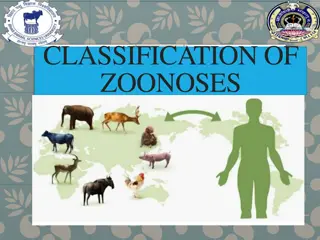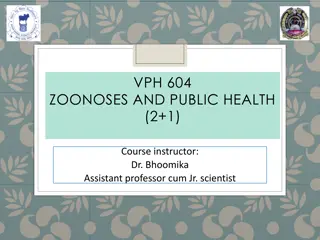Understanding the Classification of Zoonoses
Zoonoses, diseases that can be transmitted from animals to humans, are classified based on etiological agents, transmission cycle, and reservoir hosts. Etiological agents include bacteria, viruses, rickettsial, chlamydial, mycotic, and parasitic organisms. The transmission cycle categorizes zoonoses into direct, cyclozoonoses, and metazoonoses based on the life cycle of the infective organism. This classification helps in understanding the spread and control of zoonotic diseases.
Download Presentation

Please find below an Image/Link to download the presentation.
The content on the website is provided AS IS for your information and personal use only. It may not be sold, licensed, or shared on other websites without obtaining consent from the author. Download presentation by click this link. If you encounter any issues during the download, it is possible that the publisher has removed the file from their server.
E N D
Presentation Transcript
CLASSIFICATION OF ZOONOSES
Classification of Zoonoses Zoonoses can be classified in many ways, the logical and scientific basis of classification of zoonoses are as follows: oOn the basis of etiological agents oBased on transmission cycle oBased on reservoir hosts
On the basis of etiological agents a. Bacterial e.g. brucellosis, leptospirosis, listeriosis b. Viral e.g. rabies, Japanese encephalitis c. Rickettsial and Chlamydial e.g. Q fever, scrub typhus, ornithosis d. Mycotic e.g. dermatophytosis, cryptococcosis, histoplasmosis e. Parasitic e.g. toxoplasmosis, visceral larva migrans, hydatidosis
Based on transmission cycle (Baesd on the type of life cycle of the infective organism) 1. Direct zoonoses: These zoonotic diseases are perpetuated in nature by a single vertebrate species Infection is transmitted by direct contact- anthrax Indirectly through food -taeniasis, air (tuberculosis) etc. If a vector is involved in the transmission, there is no development of pathogen in the vector (mechanical transmission) e.g.Anthrax, rabies, tuberculosis, scabies etc. Cattle Cattle Cattle Cattle man
Based on transmission cycle (Based on the type of life cycle of the infective organism) 2. Cyclozoonoses Require two or more vertebrate hosts to complete transmission cycle of an infectious agent Classified into two sub types (a) Obligatory cyclozoonoses Man is must for completion of life cycle i.e. compulsory host. e.g. Taenia solium, Taenia saginata Man Pig Pig Man
Based on transmission cycle (Based on the type of life cycle of the infective organism) (b) Non-obligatory cyclozoonoses Man is accidentally involved in transmission cycle. Many a times, these zoonoses form cul-de-sac in man e.g. Hydatidosis (Echinococcus granulosus) Dog Sheep/ Cattle Sheep/ Cattle Dog man
Based on transmission cycle (Based on the type of life cycle of the infective organism) 3.Metazoonoses Both vertebrate and invertebrate species are involved in the transmission of an infectious agent In invertebrate hosts, infectious agent may multiply, develop or remain dormant Classified into: four subgroups (a) Metazoonoses type I :One vertebrate and one invertebrate host. e.g. Yellow fever, plague Rat Rat Flea man Flea (plague)
Based on transmission cycle (Based on the type of life cycle of the infective organism) (b) Metazoonoses type II One vertebrate and two invertebrate hosts e.g. Paragonimiasis Man Crab Snail Crab Dog Snail (Paragonimiasis)
Based on transmission cycle (Based on the type of life cycle of the infective organism) (c) Metazoonoses type III Two vertebrate and one invertebrate hosts e.g. Clonorchiasis Man Fish Snail Fish Dog Snail (Clonorchiasis)
Based on transmission cycle (Based on the type of life cycle of the infective organism) (d) Metazoonoses type IV Transovarian transmission e.g. Tick-borne encephalitis Sheep man Tick Tick Sheep
Based on transmission cycle (Based on the type of life cycle of the infective organism) 4. Saprozoonoses Require a non-animate substance for completion of life cycle in addition to vertebrate or invertebrate host i.e. food, soil, clothing, water, grass or plants An infectious agent may multiply, develop or propogate on inanimate site may serve as reservoir or source of an infectious agent It is subdivided into 3 types: a. Saproanthrapozoonoses b. Saproamphixenoses c. Saprometanthrapozoonoses
Based on transmission cycle (Based on the type of life cycle of the infective organism) a) These diseases of animals are transmitted to human beings via non-animate substance. e.g. Cutaneous larva migrans, Ancylostomiasis Saproanthrapozoonoses Snail Dog Dog man Snail (Cutaneous larva migrans)
Based on transmission cycle (Based on the type of life cycle of the infective organism) (b) Saproamphixenoses These diseases are equally shared in nature by man and animals but are transmitted through inanimate objects e.g. Histoplasmosis, fungal infections Man Snail Snail Dog (Histoplasmosis)
Based on transmission cycle (Based on the type of life cycle of the infective organism) (c) Saprometanthrapozoonoses Require vertebrate host, invertebrate host and inanimate object for completion of transmission cycle e.g. Fascioliasis Sheep Plant Snail man
Based on reservoir hosts a) Anthrapozoonoses These are diseases of domestic and wild animals which occur in nature independent of man Human beings get infected from animals in unusual circumstances, through occupational contact or food Mostly man act as cul de sac e.g. Leptospirosis, tularemia, Rift valley fever, hydatidosis, rabies man Dog Dog (Leptospirosis)
Based on reservoir hosts b) Zooanthroponoses : These are diseases which normally pass from man to othervertebrate animals. e.g. Tuberculosis (Human type), amoebiasis, diptheria (Human type). Cattle Man Man Tuberculosis (Human type)
Based on reservoir hosts c) Amphixenoses These are ubiquitous diseases for which man as well as vertebrate animals act as host. The agent can pass from man to animal and animal to man e.g. Streptococcosis, non-host staphylococcosis specific salmonellosis, Man Cattle Man Cattle (Streptococcosis)
Management of Zoonoses The control of zoonoses involves the following steps - Vector Control Early clinical rcognition & prompt intervention Reservoir Control Global Surveillance Diagnostic Facilities Control of Zoonoses Prudent antimicrobial usage Improved public health & infrastructure Health Education Immunization Intersectoral Co-ordination























